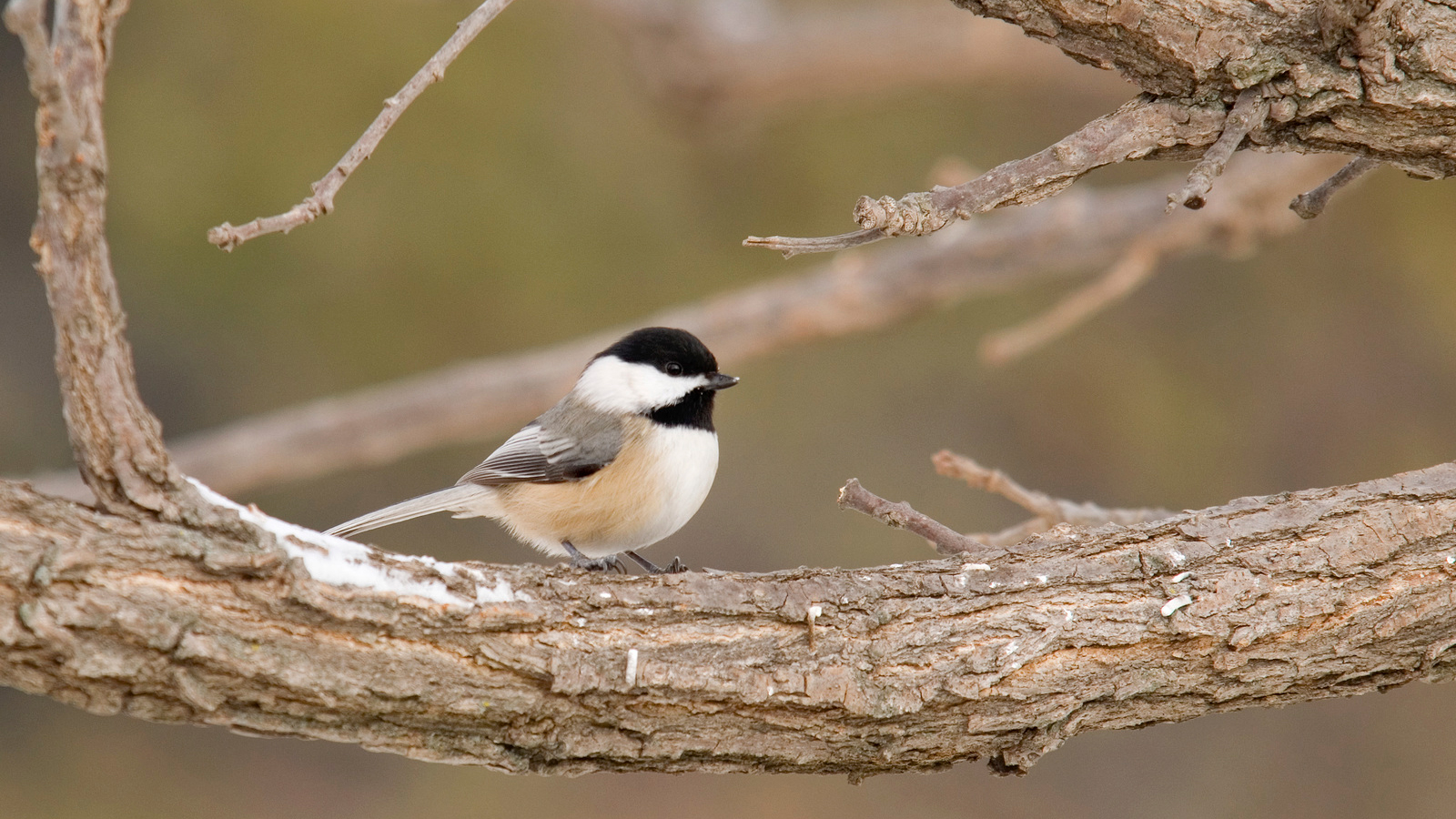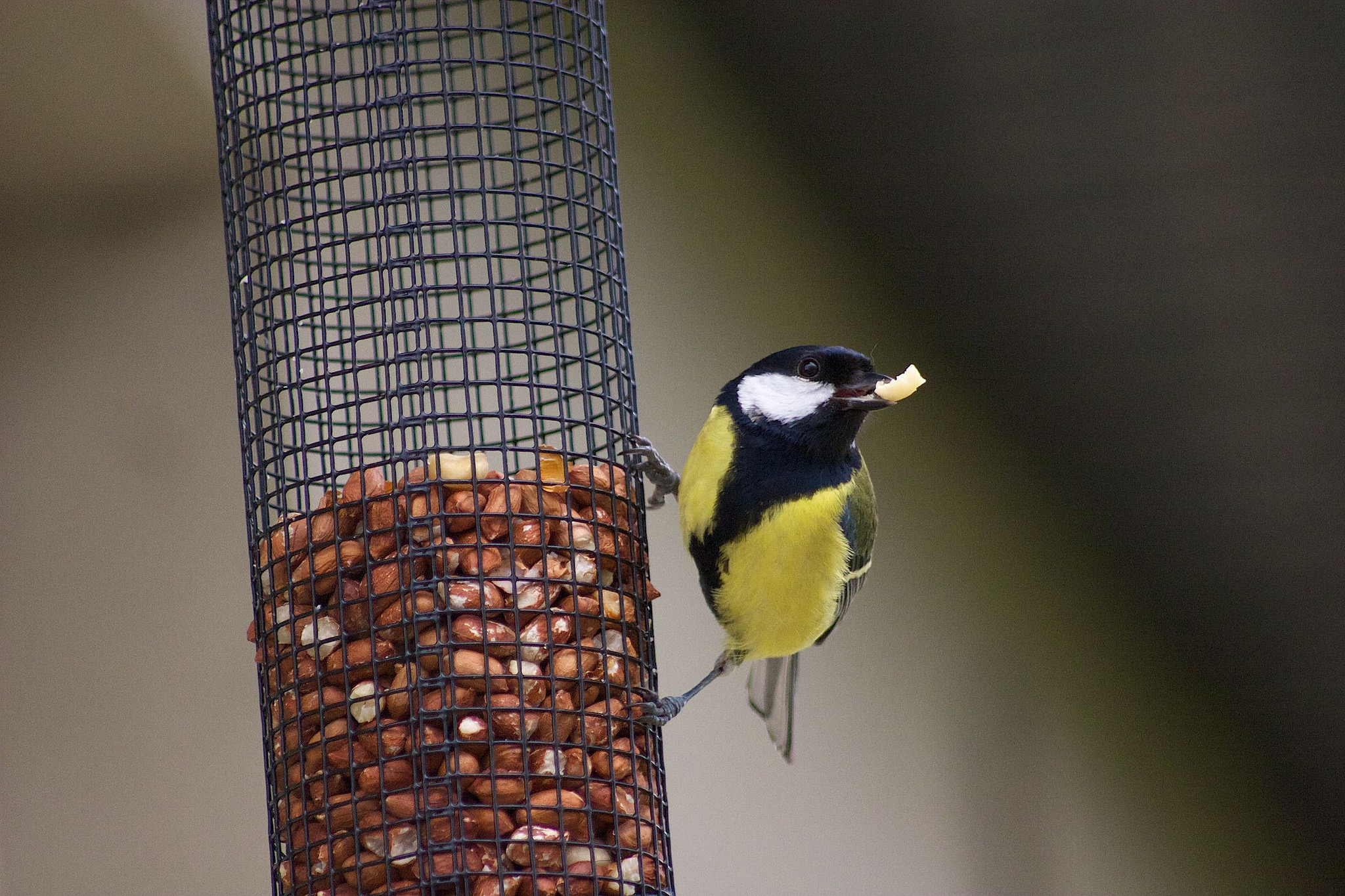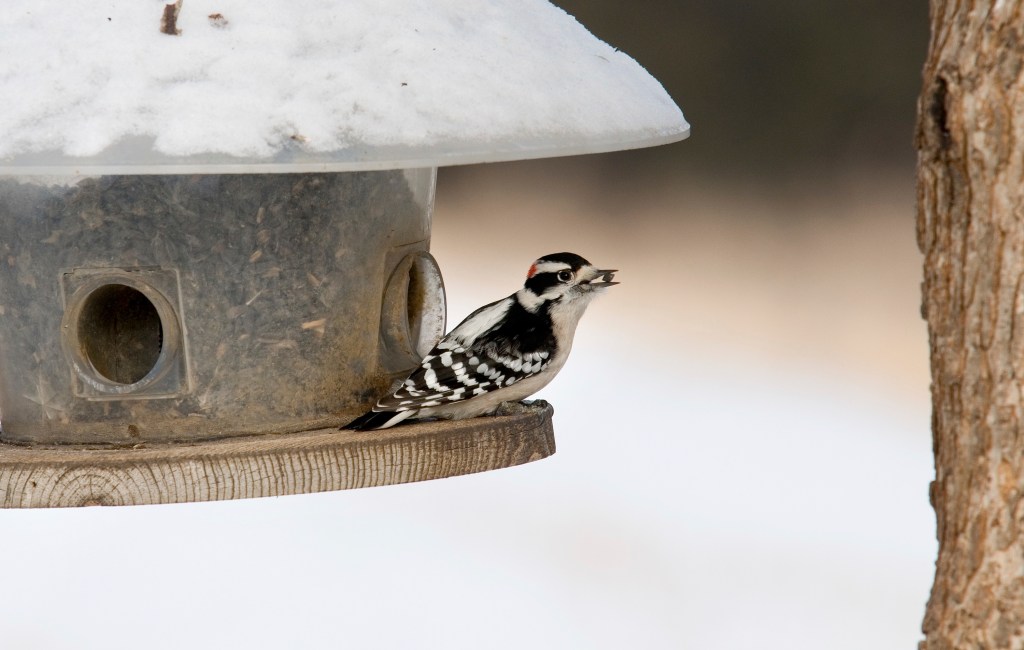Winter bird feeding is one of the most popular ways for people to interact with nature, and most do it to help birds get through these tough months. But what does this really mean for conservation? Does feeding help or hurt birds?
More than 40 percent of U.S. households feed their backyard birds, and in the United Kingdom, the rate is as high as 75 percent.
Despite the widespread popularity of bird feeding, scientists are still building a basic understanding of its impacts.
As we might guess, a number of studies show generally positive impacts of bird feeding. For example, the overwinter survival of birds is enhanced by bird feeding.
This is especially true during the coldest times, when some hungry birds might otherwise lose the battle with the elements1.
A study conducted during winter in Wisconsin showed that black-capped chickadees with access to bird seed had a much higher overwinter survival rate (69 percent) as compared to those without access to human-provided seed (37 percent survival).
Furthermore, some studies have shown that birds making it through the winter in better physical condition see those benefits carry over into the nesting season.
Bird feeding produces significantly earlier egg laying dates, larger clutches of eggs, higher chick weights and higher overall breeding success across a wide range of bird species2,6.

The greatest impact of feeding is seen when birds are most challenged, such as after particularly harsh winters, or when birds are young and inexperienced, or when they are living in low-quality habitats2. Feeding can promote the survival and reproduction of the not-quite-fittest.
But in contrast to these straightforward results – showing that bird feeding makes for better-off birds – a few studies indicate that, at least in some situations, there may be unintended consequences of bird feeding.
A European relative of the black-capped chickadee, the blue tit, was studied in the United Kingdom to examine the impact of bird feeding on nesting success.
One research group3,4 found that birds fed during winter subsequently laid a smaller number of eggs that had lower hatching success and ultimately fledged fewer young than birds that weren’t fed at all. The offspring that did fledge weighed less and had a lower survival rate than the young of unfed birds.
An additional U.K. study of the blue tit and another chickadee-like species, the great tit, had similar findings.
Both species, when they had access to bird food, laid fewer eggs, had lower hatching success, and ultimately had fewer chicks fledged.

Note, however, that these are just two studies demonstrating a negative effect of bird feeding – among a majority that show positive effects.
Nonetheless, the striking findings of lower reproductive success in supplementally fed birds need some explanation. Unfortunately, it was beyond the scope of these U.K. studies to definitively explain how bird feeding resulted in lower reproductive success, but the authors offer several possible hypotheses.
One possibility the authors suggest is that the bird feeding provided an irresistible diet that was unbalanced – too high in fat to produce high-quality eggs. More protein, micronutrients, and antioxidants than are provided by bird seed may be needed to produce high-quality eggs.
Another possibility is that bird feeding allowed individuals with a lower reproductive capacity which ordinarily would not survive the winter the chance to nest.
A final possibility is that the feeders were placed in poor quality nesting habitat – leading the birds to choose these suboptimal sites as nesting areas in the spring.
More research needs to be done across a wider geographic area and on more species to understand not only the impacts of bird feeding on reproductive success, but also on other factors such as disease transmission, species range expansion, and population trajectories.
Citizen scientists can help by participating in initiatives like Project FeederWatch that ask people with bird feeders to share their observations. What you see in your own backyard can contribute to the efforts to answer these questions.




There are two differences between the feeding of wild birds in Wisconsin and the UK, which may be interconnected.
First, the climate is very different. The extremes of weather which routinely occur in Wisconsin would be regarded as verging on the apocalyptic in the UK. The climate in the UK is much more akin to that in the Pacific Northwest: damp, rarely too got, rarely too cold. Also, while British gardens tend to offer a greater variety of plants, etc, lower Summer temperatures tend to mean they don’t get the colossal weight of bugs common in the US (until recently).
Second, the type of feeding that goes on in the UK is somewhat different, relying heavily on peanuts, millet and suet balls. In general I would say that the quality and variety of food is lower than in the US. Many people feed stale bread to birds.
I believe the feeding of peanuts in a damp climate means more mold?
In conclusion, I think using these studies to compare the effects of winter feeding is like comparing apples and oranges. Not enough factors are controlled for.
Anything that connects humans to their fellow creatures has to be a plus. Bird-feeding leads to closer observation, which leads to awareness, which leads to … who knows … better habitat maybe.
The biggest issue is that feeders draw as many, if not more, invasive birds. Starlings and Asian Sparrows love bird seed and out compete the treasured bluebirds and martins of my area (Colorado). Asian sparrows are in direct competition for nesting sites with bluebirds. Really the only appropriate food in my area is thistle seed in a thistle feeder for the finches.
Thank you cool Green Facts for helping me learn more about feeding birds in the winter.
It would be interesting to follow up with a conversation about the effects of unintentional feeding of corvids, such as through poorly-managed food-waste or leaving pet food/chicken scratch accessible to jays and crows (etc.). Do these birds experience greater nesting success, with long-term secondary effects on other bird species?
With a diversity of seed, fruit, nectar and suet favored by various birds, my 4 acre garden has become home to families of birds who stay with each new generation, while migratory birds return year after year for warm or cold months
Native plants and trees help attract bees and butterflies
The birds have housing, water sources and sanctuary, as well as hutches for ground feeders of all sizes Inc wild turkeys. The many feeders all have hoods protecting birds from rain and snow and the deck rail hayracks become a safe dry place for an afternoon roost off the cold snow. Plastic feeders work well in winter to prevent bird feet sticking to icy metal.
Thanks for the great, informative article. We’re trying to educate the public here in Australia about the best practices of wild bird feeding. http://naturemates.com.au/best-practice/. It can be a contentious issue down here, mostly due to the lack of information and knowledge.
I thought it would be good to join the feeder watch, since I have seen some very unique birds for my area of the country. However, I object to having to pay a fee for giving you free data.
Hi Joe, very useful information, thanks. I think you may be right that the studies showing negative impacts of feeding birds may be influenced by a number of factors. We find that if birds are fed a varied and balanced diet then they generally thrive and create a long-lasting colony. It may be that some commercial mixes are too high in fillers/carbohydrates and not high enough in proteins and minerals. We find that for the winter, mealworm rich mixes, niger seeds and nuts aid in the local bird population’s survival.
On another note, trying to promote people helping our native greenfinch populations here in the UK which are showing alarming declines, would be great if you could share http://www.littlepeckers.co.uk/blog/wild-bird-mix-helping-greenfinches/
Thanks
David
Sooooo, To feed, or not to feed must be the question…..what do you suggest???
Interesting speculation about herbicides and pesticides in feeder seed…but how about the big picture with regard to lawn and garden care? If we are luring birds into the yard with food and habitat for our viewing pleasure, I think it’s prudent to ditch the residential chem use so prevalent in hopes of achieving that “monoculture golf course” look many desire. Non-toxic lawns with 39 different plants growing in them are actually interesting to me and the beetles and grubs living in them provide a nice balance of real living protein for birds visiting the seed feeders. Nothing like backyard birds taking Cotinis nitida in flight, it’s a pleasure to watch.
Not denying the possibility of feeder nutrients alone being responsible for some of the negative data noted in studies, but I’d like to see a broader consideration of factors potentially responsible for such effects. Lots of nasty stuff can jump into the food chain when human activity in an area is considered and analyzed, every spring those lawn care flyers are mailed to any house with more than three blades of grass growing. Nearby agricultural use of chems and effective concentrations required? Wow! It’s scary for human health, too.
Could be that the feeder seed is the safest stuff around and it’s everything else we do that causes the problems in residential areas. Even after years of providing seed, I notice a huge shift in foraging behavior when live protein is available in the area thus skeptical of the “diet training” theories pertaining to birds. A midwinter stonefly hatch will result in backyard feeders being completely ignored by most every species as they head to the creeks to gorge themselves. Birds seem to exploit near every food source imaginable in an area and some we don’t even think of, thus it’s difficult to narrow down the problem.
There is another important aspect to the impact of bird feeding: the birdseed may be grown using large scale monoculture agriculture, with all the attendant consequences. This kind of agriculture replaces birding habitat with a very limited environment which may support a few migratory birds, but probably not the birds that would thrive in a more diverse habitat.
So I feed, but I worry 🙂
Could there be a parallel with other creatures who tend to produce more offspring when they are over-hunted or have high losses do to adverse weather, lack of food, or loss of habitat? The coyote comes to mind. “Adapt to survive”.